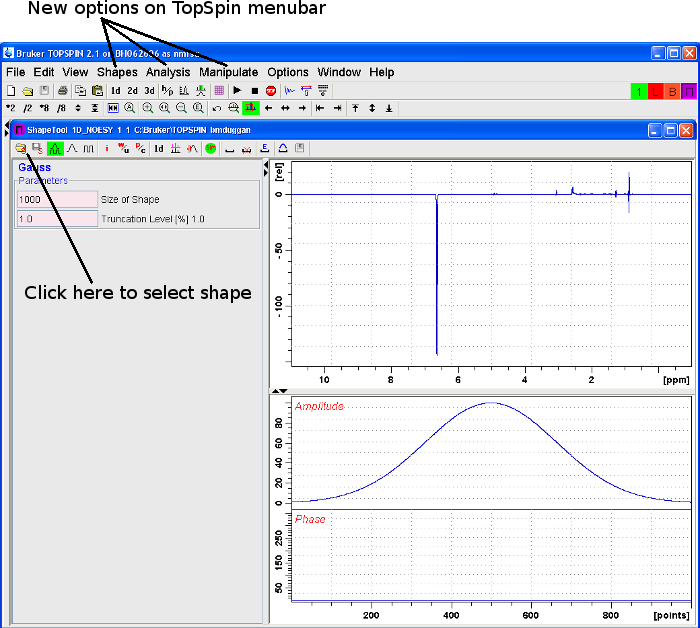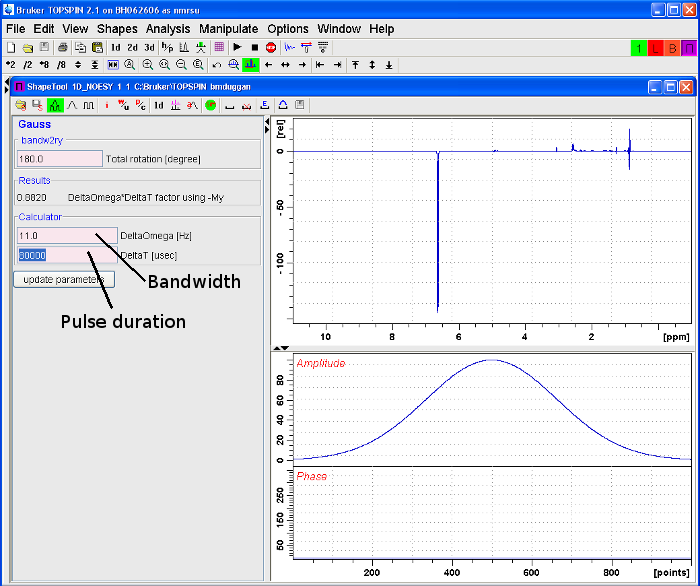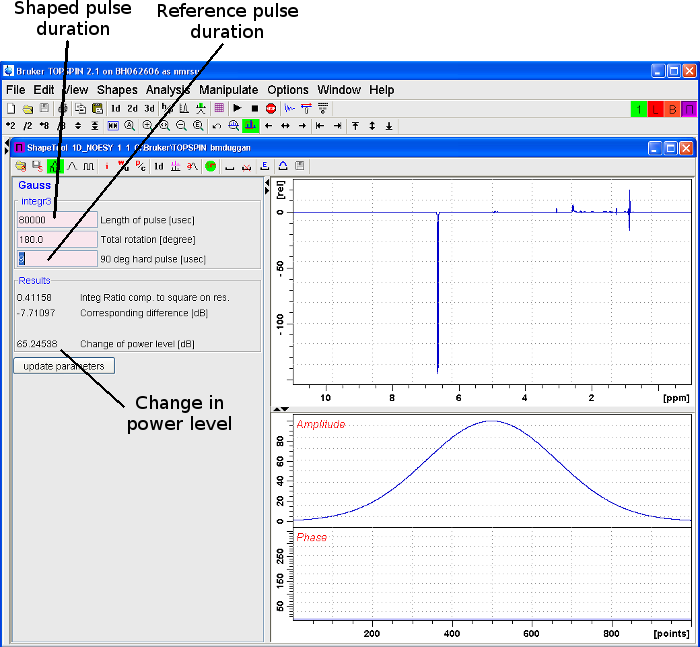Selective Experiments
To run an experiment with a selective pulse, three parameters must be set - the shape of the pulse, its duration, and its power. On Bruker spectrometers running TopSpin the easiest way to calibrate these parameters is to use Shape Tool. The complete manual for Shape Tool can be found here.
Shape Tool
In TopSpin Shape Tool can be started with the command "stdisp" or by selecting "Spectrometer -> Shape Tool" from the top menu bar. This opens a new window with its own menu bar along the top and changes the options on the menu bar of the main TopSpin window.

To select a shape to work on click the folder icon on the left of the Shape Tool menu bar, select "shape" from the drop down menu, and pick a shape from the list that appears. The choice of shape depends on the application. The table below gives some suggestions on appropriate shapes for different experiments.
| Experiment | Purpose | Shape |
|---|---|---|
| 1D selective TOCSY, NOESY | 180o 1H refocusing | Gaus1_180r.1000 |
| 2D 13C HSQC | adiabatic 180o 13C inverting | Crp60,0.5,20.1 |
| 2D band-selective HSQC, HMBC | 180o 13C refocusing | G3.256 |
| 2D HOBS TOCSY | 180o 1H refocusing | Reburp.1000 |
| 2D HSQC with water flipback | 90o 1H excitation | Gaus1.1000 |
| 2D SO-FAST HMQC | rapid 120o 1H excitation | Pc9_4_120.1000 |
| 3D triple resonance | 180o 13C refocusing | Q3.1000 |
Duration
The duration of the selective pulse determines its selectivity. The longer the pulse, the narrower the region that is excited. The region excited by the pulse is known as the bandwidth.
To determine the duration of the pulse first decide on the bandwidth by measuring in Hz the region you wish to excite. Then with Shape Tool open, select "Analysis -> Calculate Bandwidth for ..." from the TopSpin menu bar. The exact option to select depends on the purpose of the shaped pulse. For a 1D selective NOESY, where the shaped pulse is a 180o pulse refocussing xy magnetisation, the correct option is "Calculate Bandwidth for Refocusing -My". To calculate the duration for a 90o pulse use "Calculate Bandwidth for Excitation"
After selecting the appropriate bandwidth calculation the pink text boxes in the left panel will change. Check that the value for total rotation is correct. In the bandwidth box labelled "DeltaOmega [Hz]" enter the desired bandwidth and press enter. The value in the pulse duration box, labelled "DeltaT [usec]", will update to give you the pulse duration corresponding to your desired bandwidth. It is also possible to enter a duration and determine the corresponding bandwidth.

Power
The power of the shaped pulse has to be adjusted to match the duration so that enough power is applied to produce the desired rotation of the magnetisation. Different calculation methods are used for classical pulses and for adiabatic ones.
Classical pulses
To calculate the power required for a classical shaped pulse select "Analysis -> Integrate Shape" from the TopSpin menubar. The textboxes in the left panel will change. In the topmost textbox enter the duration of the shaped pulse in μsec. Check the total rotation is set correctly. Then, in the third textbox enter the length of the reference pulse, the high power 90o pulse. This is normally set by the "getprosol" or "gpro" command and can be found by looking up the value of "p1". After setting the three values, pressing enter will update the value labelled "Change of power level [dB]". The change in power level must be added to the power for the reference pulse, i.e. "pl1", and entered as the power for the shaped pulse. For 90o shaped pulses the power level is normally "sp1", while for 180o pulses its typically "sp2". Check the pulse sequence comments to be sure.

Adiabatic pulses
For adiabatic pulses (e.g. "Crp60,0.5,20.1", "Crp60_Xfilt.2") the appropriate power calculation option is "Analysis -> Integrate Adiabatic Shape". Selecting this option brings up the same textboxes as for the classical shapes except for the total rotation box. This textbox is missing since the total rotation cannot be adjusted for adiabatic shapes. The power change is calculated by entering the duration of the adiabatic pulse and of the reference pulse, as for the classical shapes.Written by Brendan Duggan. Last modified 2022-Jul-22
Section 'Sub' Navigation:

